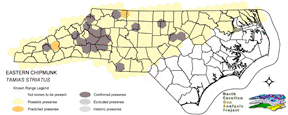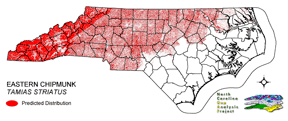
| Taxa: |
| Order: |
| Family: |
| Mammalia |
| Rodentia |
| Sciuridae |
| NatureServe Global Rank: |
| NatureServe State (NC) Rank: |
| G5 |
| S5 |
| Federal Status: |
| NC State Status: |
| --- |
| --- |


| Land Unit |
| US Fish & Wildlife Service |
| US Forest Service |
| US National Park Service |
| US Department of Defense |
| NC State Parks |
| NC University System |
| NC Wildlife Res. Com. |
| NC Forest Service |
| NC Div. of Coastal Mgmt. |
| Local Governments |
| Non-Governmental Org. |
| Other Public Lands |
| Private Lands |
| GAP Status 1-2 |
| All Protected Lands |
| Statewide |
| Hectares |
| 1,674.81 |
| 393,755.04 |
| 4,025.70 |
| 109,545.39 |
| 20,118.51 |
| 769.23 |
| 26,484.57 |
| 3,133.29 |
| 24.21 |
| 8,677.98 |
| 7,632.36 |
| 1,070.73 |
| 3,298,885.47 |
| 191,494.20 |
| 575,372.46 |
| 3,875,797.29 |
| Acres |
| 4,138.54 |
| 972,989.70 |
| 9,947.72 |
| 270,692.50 |
| 49,713.91 |
| 1,900.81 |
| 65,444.78 |
| 10,600.45 |
| 59.82 |
| 21,443.75 |
| 18,859.97 |
| 2,645.83 |
| 8,151,721.94 |
| 476,050.30 |
| 1,424,633.96 |
| 9,580,159.73 |
| % of Dist. on |
| Prot. Lands |
| 0.3 % |
| 68.4 % |
| 0.6 % |
| 19.0 % |
| 3.5 % |
| 0.1 % |
| 4.6 % |
| 0.5 % |
| < 0.1 % |
| 1.2 % |
| 1.2 % |
| 0.1 % |
| 0.0 % |
| 33.3 % |
| ----- |
| ----- |
| % of Dist. on |
| All Lands |
| < 0.1 % |
| 10.2 % |
| 0.1 % |
| 2.8 % |
| 0.5 % |
| < 0.1 % |
| 0.7 % |
| < 0.1 % |
| < 0.1 % |
| 0.2 % |
| 0.2 % |
| < 0.1 % |
| 85.1 % |
| 4.9 % |
| ----- |
| ----- |
|
The range of the chipmunk in North Carolina extends from the northeast coastal plain and the central and northern piedmont, where its populations are scattered, to the Appalachian mountains, where it is common to abundant (Lee et al. 1982, Webster et al. 1985). Associated with deciduous forests of oak-hickory and beech-maple (Whitaker and Hamilton 1998). Chipmunks seek out rock work, dilapidated buildings, large rotting logs, and thick underbrush in open forest, at forest edges or in other wooded or semi-open habitats to place their burrows. Park-like conditions are not out of the question as well. NATURE SERVE GLOBAL HABITAT COMMENTS: Prefers deciduous woodlands with ample cover, such as brush piles/logs, rocky forested slopes, ravines. Also found in brushlands and hedgerows. Commonly climbs trees/shrubs. Burrows often open at edge or rock, near base of tree, or under edge of building. Nest is generally constructed below ground in an extensive burrow system. |
| Code | Name | Description | NC Natural Heritage Program Equivalent |
| 121 | Maritime Pinelands | Loblolly forests and woodlands of the outer coastal plain. | Estuarine Fringe Loblolly Pine Forest |
| 17 | Maritime Forests and Hammocks | Maritime forests and woodlands dominated by live or sand laurel oak. Estuarine Fringe forests dominated by loblolly pine. | Coastal Fringe Evergreen Forest, Maritime Deciduous Forest, Maritime Deciduous Forest |
| 63 | Coastal Plain Mesic Hardwood Forests | Beech dominated forests with white oak and northern red oak as possible co-dominants. Dry-mesic to mesic forests on slopes and small stream bottoms in the coastal plain. | Mesic Mixed Hardwood Forest, Basic Mesic Forests |
| 138 | Coastal Plain Dry to Dry-Mesic Oak Forests | Oak dominated forests of the coastal plain. Includes white oak forests with water oak or northern red oak and hickories as co-dominants. | Dry Mesic Oak Hickory Forest, Basic Oak Hickory Forest, Dry Oak Hickory Forest |
| 230 | Piedmont Mesic Forest | American Beech - Red Oak - White Oak Forests. | Mesic Mixed Hardwood |
| 383 | Piedmont Mixed Successional Forest | Generally loblolly mixed with successional hardwoods. Sweetgum, tulip poplar and red maple are common co-dominants in these successional forests. | No equivalent |
| 228 | Piedmont Dry-Mesic Oak and Hardwood Forests | Primarily oak dominated forests, white oak is often dominant, with co-dominants including . Also represented by sweetgum and tulip poplar dominated forests. | Dry Mesic Oak Hickory Forest, Basic Oak Hickory Forest, Dry Oak Hickory Forest |
| 382 | Dry Mesic Oak Pine Forests | Mixed forests of the coastal plain and piedmont. Includes loblolly pine with white, southern red and/or post oak and loblolly with water oak. On basic sites of the piedmont, eastern red cedar may co-occur with post, black, and blackjack oaks. | Dry Mesic Oak Hickory Forest, Xeric Hard Pan Forest, Chestnut Oak Forest, Dry Mesic Oak Hickory Forest, Dry Oak Hickory Forest |
| 51 | Deciduous Cultivated Plantation | Planted deciduous trees. Includes sweetgum and sycamore plantations. | No equivalent |
| 36 | Successional Deciduous Forests | Regenerating deciduous trees with a shrub stature. Commonly dominated by sweetgum, tulip poplars and maples. | No equivalent |
| 522 | Northern Hardwoods | High Elevation forests including yellow birch, American beech, and yellow buckeye. Includes forests with Hemlock and Yellow Birch. | Northern Hardwoods Forest, Boulderfield Forest |
| 525 | Appalachian Oak Forest | A variety of oak forest types including Black, White, Scarlet Oaks in dry to mesic situations. Includes forests historically co-dominated by American Chestnut. | High Elevation Red Oak Forest, Montane White Oak Forest |
| 526 | Appalachian Cove Forest | Mixed Mesophytic forests of the mountains. Includes tuliptree, basswood, yellow buckeye and surgar maple. This class is mapped to include cove forests dominated or co-dominated by hemlock. | Rich Cove Forest, Acidic Cove Forest |
| 527 | Appalachian Hemlock | Upland hemlock forests of the moutains region. Vary from side slopes to steep slope positions. | Canada Hemlock Forest |
| 529 | Appalachian Xeric Mixed Forest | Mixed forests with Virginia, Shortleaf, Eastern White Pine, Table Mountain and Pitch pines in combination with xeric oak species. Oaks include, white, Southern Red, black, and rock chestnut. | Pine Oak Heath |
| 530 | Appalachian Xeric Deciduous Forest | Deciduous forests in the mountains dominated by Xeric Oak species. Species include, white, Southern red, black, and rock chestnut. | High Elevation Red Oak Forest, Montane White Oak Forest |
|
Snyder, D.P. 1982. Tamias striatus. Am. Soc. Mamm., Mammalian Species No. 168 8 pp.
Allen, E.G. 1938. The habits and life history of the eastern chipmunk (Tamias striatus lysteri). 122 pp. Jones, J. K., Jr., et al. 1992. Revised checklist of North American mammals north of Mexico, 1991. Occas. Pap. Mus., Texas Tech Univ. (146):1-23. Wilson, D. E., and D. M. Reeder (editors). 1993. Mammal Species of the World:a Taxonomic and Geographic Reference. Second Edition. Smithsonian Institution Press, Washington, DC. xviii + 1206 pp. Whitaker, J.O. Jr. and W.J. Hamilton, Jr. 1998. Mammals of the eastern United States. Cornell Univ. Press, Ithaca, New York. 583 pp. Yerger, R.W. 1953. Home range, territoriality and populations of the chipmunk in central New York. J. Mamm. 34(4):448-458. Yahner, R.H. 1978. The adaptive nature of the social system and behavior in eastern chipmunk, Tamias striatus. Beh. Ecol. and Sociobiol. 3:397-427. Lee, D. S., L. B. Funderburg Jr., and M. K. Clark. 1982. A distributional survey of North Carolina mammals. Occasional Papers of the North Carolina Biological Survey, No. 1982-10. North Carolina State. Mus. Nat. Hist., Raleigh, North Carolina. 72 pp. Lacki, M. J., M. J. Gregory, and P. K. Williams. 1984. Summer activity of Tamias striatus in response to supplemental food. J. Mamm. 65:521-524. Godin, A.J. 1977. Wild Mammals of New England. Johns Hopkins University Press, Baltimore. 304 pp. Elliot, L. 1978. Social behavior and foraging ecology of theeastern chipmunk (Tamias striatus) in the Adirondack Mts. Smithsonian Contrib. to Zool. No. 265. 107 pp. Layne, J. N., editor. 1978. Rare and endangered biota of Florida. Vol. 1. Mammals. State of Florida Game and Freshwater Fish Commission. xx + 52 pp. Hall, E. R. 1981. The Mammals of North America. Second edition. 2 Volumes. John Wiley and Sons, New York, New York. Schwartz, Charles W., and Elizabeth R. Schwartz. 1981. The wild mammals of Missouri. University of Missouri Press, Columbia. 356 pp. Wishner, L. 1982. Eastern chipmunks. Secrets of their solitary lives. Smithsonian Inst. Press, Washington, D.C. 144 pp. Baker, Rollin H. 1983. Michigan mammals. Michigan State University Press. 642 pp. Webster, W. D., J. F. Parnell and W. C. Biggs Jr. 1985. Mammals of the Carolinas, Virginia, and Maryland. The University of North Carolina Press, Chapel Hill, NC. Caire, W., J. D. Tyler, B. P. Glass, and M. A. Mares. Z. Marsh (illustrator). 1989. Mammals of Oklahoma. University of Oklahoma Press, Norman. Oklahoma. 567 pp. Tryon, C.A. and D.P. Snyder. 1973. Biology of the eastern chipmunk, TAMIAS STRIATUS:Life tables, age distributions, and trends in population numbers. J. Mammalogy, 54(1):145- 189. |
For more information please contact them at:
NC-GAP Analysis Project
Dept. of Zoology, NCSU
Campus Box 7617
Raleigh, NC 27695-7617
(919) 513-2853
www.basic.ncsu.edu/ncgap